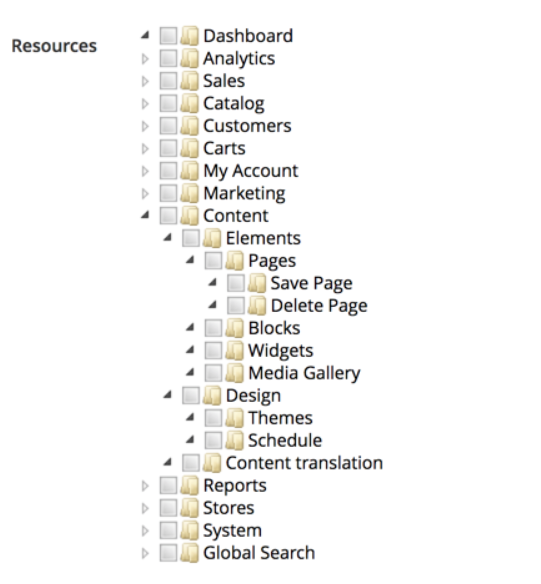Magento web API 区分三种不同的用户类型:
> **Guest**: 能够访问 `anonymous` 资源
```xml
<resources>
<resource ref="anonymous" />
</resources>
```
> **Customer**: 能够访问 `self` 类型的资源
```xml
<resources>
<resource ref="self"/>
</resources>
```
> **Integrator: **能够访问 `acl.xml` 中定义好的特定资源
```xml
<resources>
<resource ref="Magento_Cms::save"" />
</resources>
```
<br />为了更好的理解上面的内容,我们需要理解 `<VendorName>/<ModuleName>/acl.xml` 和 `<VendorName>/<ModuleName>/webapi.xml` 的关联关系,我们在 `acl.xml` 中定义对应的资源访问权限,下面的内容是 <MAGENTO_DIR>/module-cms/etc/acl.xml 中的代码:
```xml
<config>
<acl>
<resources>
<resource id="Magento_Backend::admin">
<resource id="Magento_Backend::content">
<resource id="Magento_Backend::content_elements">
<resource id="Magento_Cms::page" title="Pages">
<resource id="Magento_Cms::save" title="Save Page"/>
</resource>
</resource>
</resource>
</resource>
</resources>
</acl>
</config>
```
我们重点关注这里的 `Magento_Cms::save` 资源,Magento 将单个 `acl.xml` 文件合并成一个大的 ACL 树形结构,我们能在 Magento 后台的两个地方看到这个树形结构:
> - Role Resource tab of the System | Permissions | User Roles | Edit | Add New Role screen
> - The API tab of the System | Extensions | Integrations | Edit | Add New Integration screen:
<br /><br />在这两个地方我们可以为管理员和特殊的 web API 集成用户设定访问权限。这并不是说标准的管理员没法执行 WEB API,在鉴权类型的章节部分我们能看到他们的差别还是很明显的。<br />
<br />这些资源自给并不做任何事情,仅仅在 `acl.xml` 文件中定义他们并不会使 CMS 页面受到保护。 这里需要控制器介入,作为访问控制的一种机制。搜索 `Magento_Cms::save` 字符能看到在 `Magento\Cms\Controller\Adminhtml\Page\Edit` 类中定义了 `const ADMIN_RESOURCE = 'Magento_Cms::save'` 。<br />
<br /> 常量 `ADMIN_RESOURCE` 的定义是在基类 `\Magento\Backend\App\AbstractAction` 中定义的,默认是 `const ADMIN_RESOURCE = 'Magento_Backend::admin'` ,该值在 `_isAllowed` 中的使用情况如下:
```xml
protected function _isAllowed()
{
return $this->_authorization->isAllowed(static::ADMIN_RESOURCE);
}
```
这里的 `AbstractAction` 类是 Magento 中其他很多 admin 控制器的基类,这也意味着控制器才是真正利用 `acl.xml` 文件中定义的资源的类。`acl.xml` 文件的主要目的是创建 ACL 树形结构。这意味着任何一个人如果要访问后台的 `cms/page/edit` ,它必须拥有 `Magento_Cms::save` 的访问权限。否则,`_isAllowed` 方法在读取到 `ADMIN_RESOURCE` 后会返回 `false` 并拒绝对应 URL 的访问。<br />
<br />对于 Web APIs,它不适用控制器,也就没有对应的 `ADMIN_RESOURCE` 常量和 `_isAllowed` 方法,API 使用 `webapi.xml` 类定义 `routes` ,一起来看看 `<MAGENTO_DIR>/module-cms/etc/webapi.xml` 文件中 CMS 页面保存相关的部分:
```xml
<routes>
<route url="/V1/cmsPage" method="POST">
<service class="Magento\Cms\Api\PageRepositoryInterface" method="save"/>
<resources>
<resource ref="Magento_Cms::page"/>
</resources>
</route>
<route url="/V1/cmsPage/:id" method="PUT">
<service class="Magento\Cms\Api\PageRepositoryInterface" method="save"/>
<resources>
<resource ref="Magento_Cms::page"/>
</resources>
</route>
</routes>
```
上面的路由定义将下面的几部分绑定在了一起,`url` 和 `method` 参数指定了那个 URL 会触发这个 `route` ,`service` 元素中的 `class` 和 `method` 参数指定了当路由被触发时要执行的接口和方法。最后 `resource` 标签中的 `ref` 指定了要执行的安全性检查针对的是哪一个资源。如果一个用户执行一个未经授权的 web API 请求,或者它不是一个拥有 `Magento_Cms::page` 资源的角色,对应的请求就不会执行到上面指定的方法。
customer 类型的用户适合使用 widgets,Magento 的结算页面就是一个很好的例子。整个结算就是一个完全使用 Ajax 的应用,这和普通的前台界面比如 CMS、分类和产品页面不同。
- Magento 基本概念
- Magento 中的 Plugin
- Magento 中的 Events 和 observers
- Magento 中的 Areas
- Magento 中的请求处理流程
- Magento 中的模块(Modules)
- Magento 中的 Cache
- Magento 中的依赖注入
- Magento 中的 Console commands
- Magento 中的 Cron jobs
- 掌握 Entities
- 理解 model 的类型
- 理解 setup scripts
- 实体扩展
- 初入 web API
- users 的几种不同类型
- 授权的不同类型
- APIs 的不同类型
- 使用 Magento 现有的 API
- 创建自定义 web APIs
- 理解 search criteria
- Magento 后台开发
- 使用 listing 组件
- 使用 form 组件
- 开发前台功能
- 搭建前台开发环境
- 初始化 & 调用 JS 组件
- 开始使用 RequireJS
- 替换 jQuery widget 组件
- 扩展 jQuery widget 组件
- 创建 jQuery widgets 组件
- 创建 UI/KnockoutJS 组件
- 扩展 UI/KnockoutJS 组件
- 自定义 Catalog
- 创建参考尺寸
- 创建当天发货
- 标识新产品
- Magento 性能最佳实践
- Magento 硬件推荐配置
- 软件推荐
- 架构参考
- 配置项最佳实践
- 高级设置
- 其他
- 如何通过 Burp Suite 和 Xdebug 来调试 Magento
- Mageno checkout 必知必会
- Magento 安装(新手必看)
- 安装流程
- 系统要求